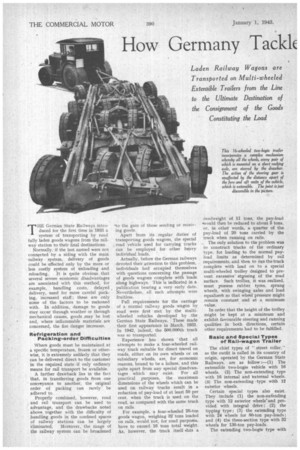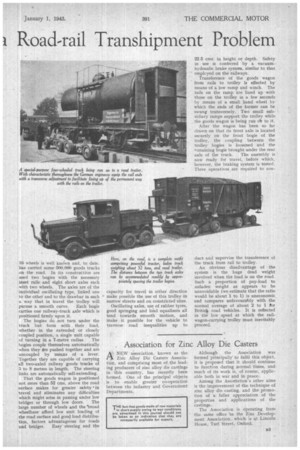How Germany Tacklc Road-rail Transhipment Problem
Page 28

Page 29

If you've noticed an error in this article please click here to report it so we can fix it.
Laden Railway Wagons are Transported on Multi-wheeled Extermible Trailers from the Line to the Ultimate Destination of the Consignment of the Goods Constituting the Load
THE German State Railways introduced for the first time in 1933 a system of transporting by road fully laden goods wagons from the railway station to their final destinations.
Normally, if the last named were not connected by a siding with the main railway system, delivery of goods could be effected only by the more or less costly system of unloading and reloading. It is quite obvious that several severe economic disadvantages are associated with this method, for example, handling costs, delayed, delivery, need for more careful packing, increased staff ; these are only some of the factors to be reckoned with. In addition, damage to goods may occur through weather or through mechanical causes, goods may be lost and, where inflammable materials are concerned, the fire danger increases.
Refrigeration and Packing-order Difficulties Where goods must be maintained at a specific temperature, frozen or otherwise, it is extremely unlikely that they can be delivered direct to the customer in the required state if only ordinary means for rail transport be available.
A further drawback lies in the fact that, in transferring goods from one conveyance to another, the original order of packing can rarely ' be adhered to.
Properly combined, however, road and rail transport can be used to advantage, and the drawbacks noted above together with the difficulty of handling goods in the confined spaces of railway stations can be largely
eliminated. Moreover, the range of the railway system can be broadened
-to the gain of those sending or receiving goods.
Apart from its regular duties" of transporting goods wagons, the special road vehicle used for carrying trucks can be employed forother heavy individual loads. '
Actually, before the German railways devoted their attention to this problem, individuals had occupied themselves with questions concerning the passage of goods wagons complete with loads along highways. This'is indicated in a publication bearing a very early date. Nevertheless, all such attempts were fruitless.
Full requirements for the carriage of a normal railway goods wagon by road were first met by the multiwheeled vehicles developed by the German State Railways. These made their first appearance in March, 1933. In 1942, indeed, the 500,000th truck was so transported.
Experience has shown that all attempts to make a four-wheeled railway truck suitable for direct travel on roads, either on its own wheels or on subsidiary wheels, are, for economic reasons, bound to be a failure, and this quite apart from any special disadvantages which may exist. For all practical purposes, the maximum dimensions of the wheels whith can be used on railway trucks result in a reduction of pay-load of at least 50 per cent, when the truck is used on the road, as compared with the same truck on rails.
For example. a four-wheeled 20-top goods wagon, weighing 32 tons loaded on rails, would not, for road purpo4es, have to exceed 16 tons total weight. As, however, the truck itself +has a deadweight of 11 tons, the pay-load would then be reduced to about 5 tons, or, in other words, a quarter of the pay-load of 20 tons carried by the truck when running on rails.
.._ The only solution to the problem was to construct trucks of the ordinary type, for loading to the normal payload limits as determined by rail requirements, and then to run the truck complete with load on to a special multi-wheeled trolley designed to prevent excessivesti6-essing of the road surface. Such trollies, it was realized, must possess rubber tyres, sprung wheels, with swinging axles and load equalizert so that wheel pressure might remain constant and at a, minimum value.
In order that the height of the trolley might be kept at a minimum and exhibit favourable steering and running qualities in both directions, certain other requirements had to be fulfilled.
Basic and Special Types of Rail-wagon Trailer
The chief types of "street roller," as the outfit is called in its country of origin, operated by the German State Railways, are as follow :—(1) The extensible two-bogie vehicle with 16 wheels. (2) The non-extending type with 16 internal and external wheels. (3) The non-extending • type with 12 exterior wheels.
Certain special types also exist. They include (1) the non-extending type with 12 exterior wheels' and provided with integral drive ; (2) the tipping type ; (3) the extending type with 24 Wheels for 80-ton pay-loads ; and (4) the three-section type with 32 wheels for 130-ton pay-loads.
The extending two-bogie type with 16 wheels is well knoiwn and, to date, has carried some 500,000 goods trucks on the road. In its construction are used two bogies with the necessary inset rails • and eight short axles each with two wheels. The axles are of the individual oscillating type, linked one to the other and to the drawbar in such a way that in travel the trolley will pursue a smooth curve. Each bogie carries one railway-truck axle which is positioned firmly upon it.
The bogies do not turn under the truck but form with their load, whether in the extended or closely coupled position, a single unit capable of turning in a 7-metre radius. The bogies couple themselves automatically when they tre pushed together and are uncoupled by means of a lever. Together they are capable of carrying all two-axled railway goods trucks of 3 to 8 metres in length. The steering links are automatically self-extending.
That the goods wagon is positioned not more than 52 ems, above the road surface makes for greater safety • in travel and eliminates any difficulties which might arise in passing under low bridges or through low doors. The large number of wheels and the 'broad wheelbase afford low unit loading of the road surface and good load distribution, factors advantageous for roads and bridges. Easy steering and the capacity for travel in either direction • make possible the use of this trolley in narrow streets and on constricted sites. Oscillating axles, use of rubber tyres, good springing and lohd equalizers all tend towards smooth motion, and make it possible for the vehicle to traverse road inequalities up to 22.5 ems; in height or depth. Safety in use is conferred by a vacuumhydraulic brake system, similar to that emplcyed on the railways.
Transference of the goods wagon from rails to trolley is effected by means of a low ramp and winch. The rails on the ramp are lined up • with those on the trolley in a few seconds by means of a small hand wheel by which the ends of the former can be swung transversely. Two small subsidiary ramps support the trolley while the goods wagon is being run oh to it.
After the wagon has been so far drawn on that its front axle is located securely on the front bogie of the trolley, the coupling between the trolley bogies is loosened and the ramaining bogie brought under the rear axle of the truck. The assembly is now ready for travel, before which, however, the braking system is tested. Three operatives , are required to con duet and supervise the transference of the truck from rail to trolley.
An obvious disadvantage of the system is the huge dead weight involved when the load is on the road. Such a proportion of pay-load to unladen Weight as appears to be unavoidable .(we estimate that the ratio would be about 1 to 1) is uneconomiC, and compares unfavourably with the normal average of about 2 to 1 for Briti4 road vehicles. It is reflected in the low speed at which the railwagon-carrying trolley must inevitably proceed.




























































